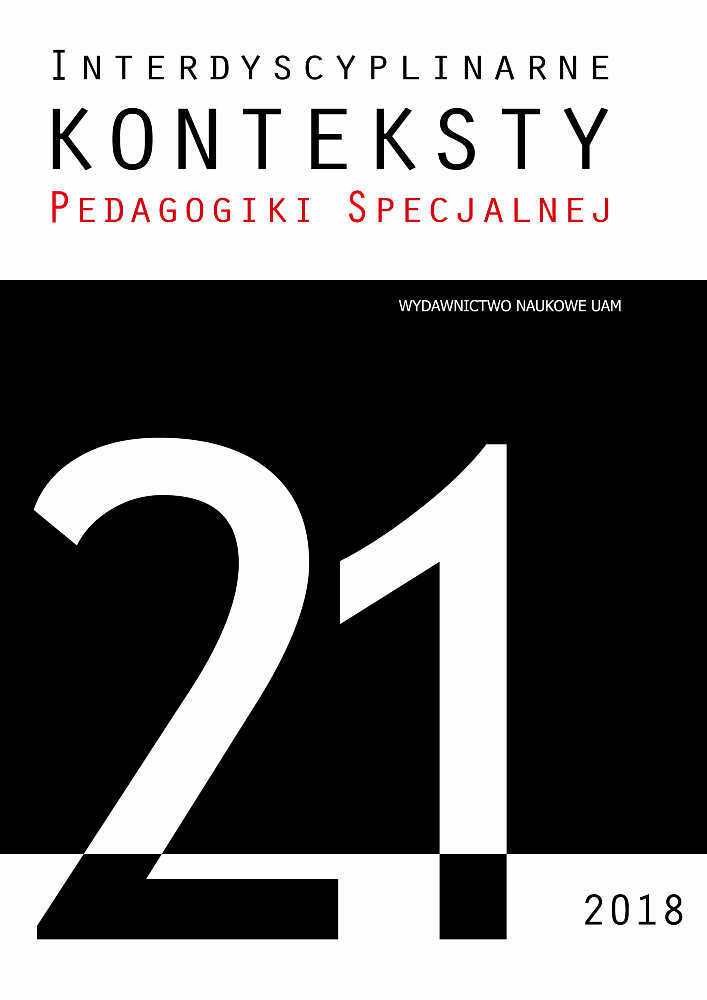Abstract
Cri du Chat syndrome (CdC) is a rare disease characterized, among others, by decreased muscle tone, microcephaly, and high palate; underdevelopment of the mandible, abnormal structure and laryngeal function (somatic symptoms) and disorders of psychomotor development and intellectual disability (psychomotor symptoms). These children have a varied level of functioning and most of them do not use verbal speech. Describing the problem of preverbal communication behaviors, the following elements were taken into account: the level of behavior in the primary communication, sensory, auditory communication, organization of behavior and signaling needs. The purpose of this article is to describe the pre-verbal behavior of children with Cri du Chat syndrome. The following questions were formulated: What is the level of pre-verbal communication (primary, sensory and auditory) of a child with CdC syndrome? What are the communicative behaviors of the child with the CdC team and at what level of organization? What is the level of signaling your needs by a child with CdC? The preverbal communication behavior of children with the Cri du Chat team presented in the article indicate that they are diverse, ranging from indicating the gesture of what they need, to vocalizing in order to provoke contact with another person. The behavior of the daughter / son indicated by the parents may constitute the basis for the teaching process of preverbal communication.
References
Buchnat M., Zespół Cri du Chat, [w:]Nieznane? Poznane. Zaburzenia rozwojowe u dzieci z rzadkimi zespołami genetycznymi i wadami wrodzonymi, M. Buchnat, K. Pawelczak (red), Wyd. Naukowe UAM, Poznań 2013, s.180.
Buchnat M., Wojciechowska A., Rzepka M., Wspieranie rozwoju mowy i komunikacji dzieci z zespołem Cr idu Chat, Forum Logopedyczne, nr 22, 2014, s. 110-120.
Campbell D.J., Early Development of Indyviduals with Cr idu Chat Syndrome (unpublished doctoral dissertation, Auburn University), Auburn 2002.
Cornish K.M., Pigram J., Developmental and behavioural characteristics of cri du chat syndrome. Archives of Disease in Childhood, n. 75, 1996, p. 448-450.
Czapiga A. Dziecko z zespołem Cri du Chat, [w:] Dzieci chore, niepełnosprawne i z utrudnieniami w rozwoju, B. Cytowska, B. Winczura, A. Stawarski (red.), Wyd. „Impuls”, Kraków 2013, s. 121-129.
Grochowalska M.,Gestykulacja i mowa. O niewerbalnym komunikowaniu się dzieci w wieku przedszkolny,. Wyd. Naukowe Akademii Pedagogicznej, Kraków 2002.
Grzesiuk L., Studia nad komunikacją interpersonalną, Pracownia Testów Psychologicznych PTS, Warszawa 1994.
Kulesza E.M., Zabawa w diagnozowaniu zdolności komunikacyjnej dziecka z upośledzeniem umysłowym, [w:] Pedagogika Specjalna. Różne poszukiwania – wspólna misja. Pamięci profesora Jana Pańczyka, Wyd. APS, Warszawa 2009, s. 248-259.
Mainardi P.C., Cri du Chat syndrome. Orphanet Journal of Rare Diseases, ojrd.biomedcentral.com, z dnia 09.09.2017.
Mainardi P.C, Pastore G., Castronovo Ch., Godi M., Guala A., Tamiazzo S., Prover S., Pierluigi M., Bricarelli F., The natural history of Cri du Chat Syndrome. A report from the Italian Register. European Journal of Medical Genetics,Volume 49, Issue 5, September–October 2006, p. 363-383.
Mainardi P. C., Albani M.L.,Pedrinazzi M., ABC – Cri du Chat (Zespół Kociego Krzyku), materiały informacyjne opublikowane przez A.B.C. Associazione Bambini Cri du chat (Stowarzyszenie na Rzecz Dzieci z zespołem Kociego Krzyku), Italia 2014.
Minczakiewicz E.M., Edukacyjny i pragmatyczny aspekt rozwoju komunikacji u dzieci ze sprzężonymi zaburzeniami rozwoju, [w:] Komunikacja-mowa-język w diagnozie i terapii zaburzeń rozwoju u dzieci i młodzieży niepełnosprawnej, E.M. Minczakiewicz (red.), Wyd. Naukowe AP, Kraków 2001, s. 26-39.
Piszczek M., Metody komunikacji alternatywnej i wspomagającej w edukacji dzieci głębiej upośledzonych umysłowo i autystycznych. Część I, Rewalidacja, nr 2(8), 2000, s. 13- 21.
Piszczek M., Metody komunikacji alternatywnej i wspomagającej w edukacji dzieci głębiej upośledzonych umysłowo i autystycznych. Część II, Rewalidacja, nr 1(9), 2001, s.3- 21.
Piszczek M., Diagnoza i wspomaganie rozwoju dziecka. Wybrane zagadnienia, Wyd. CMPPP, Warszawa 2007.
Plopa M., Więzi w małżeństwie i rodzinie. Metody badań. Wyd. „Impuls”, Kraków 2005.
Posmyk R., Midro A. T., Poradnictwo genetyczne w zespole monosomii 5p („krzyku kociego”). Cz. 1 diagnoza fenotypu. Fenotyp morfologiczny i fenotyp zachowania. Przegląd Pediatryczny, VOL 33, NO 4, 2003, s.265-272.
Rakowska A., Język-komunikacja-niepełnosprawność. Wybrane zagadnienia, Wyd. Naukowe AP, Kraków 2003.
Rodríguez-Caballero Á., Torres-Lagares D., Rodríguez-Pérez A., M. Serrera Figallo, Hernández-Guisado J-M., Machuca-Portillo G., Cri du chat syndrome: A critical review, Med Oral Patol Oral Cir Bucal. 2010 May 1;15 (3), p. 473-478.

